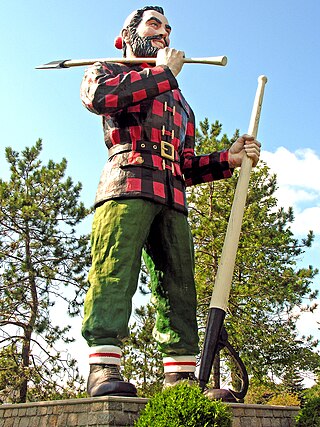
Paul Bunyan is a giant lumberjack and folk hero in American and Canadian folklore. His exploits revolve around the tall tales of his superhuman labors, and he is customarily accompanied by Babe the Blue Ox. The character originated in the oral tradition of North American loggers, and was later popularized by freelance writer William B. Laughead (1882–1958) in a 1916 promotional pamphlet for the Red River Lumber Company. He has been the subject of various literary compositions, musical pieces, commercial works, and theatrical productions. His likeness is displayed in a number of oversized statues across North America.
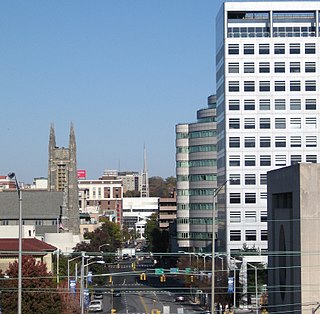
Fairfield County is a county in the southwestern corner of the U.S. state of Connecticut. It is the most populous county in the state and was also its fastest-growing from 2010 to 2020. As of the 2020 census, the county's population was 957,419, representing 26.6% of Connecticut's overall population. The closest to the center of the New York metropolitan area, the county contains four of the state's top 7 largest cities—Bridgeport (1st), Stamford (2nd), Norwalk (6th), and Danbury (7th)—whose combined population of 433,368 is nearly half the county's total population.

The 1964–1965 New York World's Fair was a world's fair that held over 140 pavilions and 110 restaurants, representing 80 nations, 24 US states, and over 45 corporations with the goal and the final result of building exhibits or attractions at Flushing Meadows–Corona Park in Queens, New York City. The immense fair covered 646 acres (2.61 km2) on half the park, with numerous pools or fountains, and an amusement park with rides near the lake. However, the fair did not receive official support or approval from the Bureau of International Expositions (BIE).
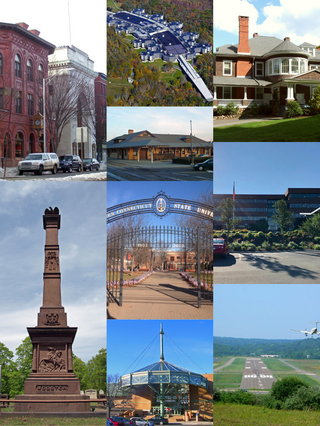
Danbury is a city in Fairfield County, Connecticut, United States, located approximately 50 miles (80 km) northeast of New York City. Danbury's population as of 2020 was 86,518. It is the seventh largest city in Connecticut.
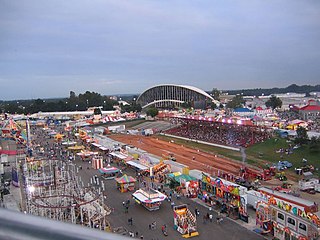
The North Carolina State Fair is an American state fair and agricultural exposition held annually in Raleigh, North Carolina. Founded in 1853, the fair is organized by the North Carolina Department of Agriculture and Consumer Services. It attracts around a million visitors over eleven days in mid-October.

Richmond Raceway (RR) is a 0.750 mi (1.207 km), D-shaped, asphalt race track located just outside Richmond, Virginia in unincorporated Henrico County. It hosts the NASCAR Cup Series, NASCAR Xfinity Series and the NASCAR Camping World Truck Series. Known as "America's premier short track", it has formerly hosted events such as the International Race of Champions, Denny Hamlin Short Track Showdown, and the USAC sprint car series. Due to Richmond Raceway's unique "D" shape which allows drivers to reach high speeds, its racing grooves, and proclivity for contact Richmond is a favorite among NASCAR drivers and fans.
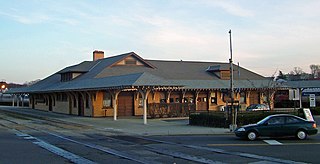
The Danbury Railway Museum is a railway museum housed in the former Union Station on the east end of downtown Danbury, Connecticut, United States. It was established in the mid-1990s following the closure of the station by the Metro-North Railroad in favor of a new station nearby, and primarily focuses on the history of railroading in southern New England and neighboring New York. In addition to the former station building, the museum has a collection of heritage railcars in the neighboring rail yard it shares with Metro-North.
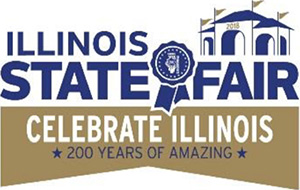
The Illinois State Fair is an annual festival, centering on the theme of agriculture, hosted by the U.S. state of Illinois in the state capital, Springfield. The state fair has been celebrated almost every year since 1853. Currently, the fair is held annually at the Illinois State Fairgrounds over an 11-day period in mid-August of each year.
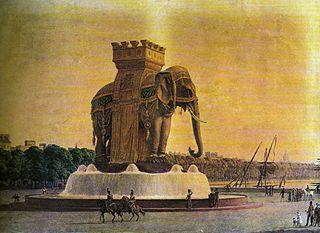
Novelty architecture, also called programmatic architecture or mimetic architecture, is a type of architecture in which buildings and other structures are given unusual shapes for purposes such as advertising or to copy other famous buildings without any intention of being authentic. Their size and novelty means that they often serve as landmarks. They are distinct from architectural follies, in that novelty architecture is essentially usable buildings in eccentric form whereas follies are non-usable, ornamental buildings often in eccentric form.

Gladys the Swiss Dairy Cow, also known simply as "Gladys", is a work of public art in the U.S. state of Connecticut. Gladys was created and is maintained by artist/owner James Lebinski since August 2002. The underlying sculpture is a fiberglass Swiss dairy cow, and is the same shape and size as the famous CowParade cows.
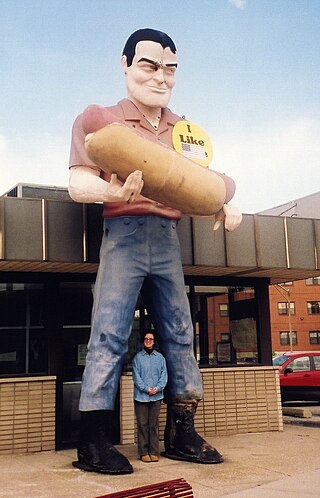
Muffler men are large moulded fiberglass sculptures that are placed as advertising icons, roadside attractions, or for decorative purposes, predominantly in the United States. Standing approximately 18–25 ft (5.5–7.6 m) tall, the first figure was a Paul Bunyan character designed to hold an axe. Derivatives of that figure were widely used to hold full-sized car mufflers, tires, or other items promoting various roadside businesses.

The Main Street Historic District in Danbury, Connecticut, United States, is the oldest section of that city, at its geographical center. It has long been the city's commercial core and downtown. Its 132 buildings, 97 of which are considered contributing properties, include government buildings, churches, commercial establishments and residences, all in a variety of architectural styles from the late 18th century to the early 20th. It is the only major industrial downtown of its size in Connecticut not to have developed around either port facilities or a water power site.

The Great Allentown Fair is an annual fair and agricultural show that is held at the Allentown Fairgrounds in Allentown, Pennsylvania. It is operated by the Lehigh County Agricultural Society. It is one of the oldest fairs in the United States, and one of the largest in the state of Pennsylvania.

Birmingham International Raceway, (BIR) was a 5/8-mile oval paved racetrack located at the Alabama State Fairgrounds in the Five Points West neighborhood of Birmingham, Alabama. It was used primarily for late-model automobile racing.
The Arizona State Fairgrounds is a permanent fairgrounds on McDowell Road, Encanto Village, within the city of Phoenix, Arizona, United States. It is currently used yearly to host the Arizona State Fair and the Maricopa County Fair, as well as for other events.
There are a number of statues of Paul Bunyan on display in the United States. Paul Bunyan was made by sculptor and artist Bill Swan.

Uncle Beazley is a life-size fiberglass statue of a Triceratops by Louis Paul Jonas. It is located near Lemur Island in the National Zoological Park in Northwest Washington, D.C.
Since the folkloric hero Paul Bunyan's first major appearance in print, the character has been utilized to promote a variety of products, locations, and services. The giant lumberjack's mass appeal has led him to become a recurring figure in entertainment and marketing, appearing in various incarnations throughout popular culture.

Great Plain is an unincorporated area in the City of Danbury, Fairfield County, Connecticut. A former farming community, only remnants exist of this once thriving agricultural hub. It is located in the northeast section of the city, sharing a border with the Beaverbrook area of Danbury and Brookfield, CT.















